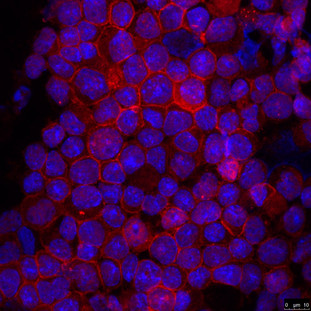Joint press release by NCT/UCC Dresden and NCT Heidelberg
Hemopoietic stem cells are the origin of all different blood cells. But how and where is it decided which type of blood cell a stem cell develops into? A team of researchers led by scientists at the National Center for Tumor Diseases (NCT) in Dresden and Heidelberg has now come one step closer to answering this question: The researchers were able to show for the first time that a specific switchpoint called EVL/MIR342 in the genetic material of stem cells plays an important role in their further development into one of the two blood cell lineages. They also found evidence that the particularly active region of the genome could be involved in the formation of various forms of blood cancer. The results of the study were published in the journal "Leukemia".
The starting point of all blood cells are so-called stem cells in the bone marrow. Long-term stem cells can renew themselves, divide and differentiate into various blood cells even after years. This highly complex ability requires precise regulation of all genes in the cell's genome. Responsible for this control function are genetic switchpoints - particularly active, regulatory regions in the genome at which genetic information is increasingly read. A team of researchers has now been able to decipher the function of the EVL/MIR342 switchpoint for the first time. The genetic material contains the genetic blueprint for a protein called EVL and for a short RNA molecule - microRNA number 342. The scientists showed that the interaction of these two gene products has a decisive influence on which of the two blood cell lineages - myeloid or lymphoid cells - the stem cell develops into.
"The mechanism now described is an important building block for better understanding early hematopoiesis as well as the causes of blood cancer at the genetic level," says Prof. Hanno Glimm, one of the managing directors at the NCT/UCC Dresden, who heads a research group at the DKFZ in Heidelberg in addition to his department there. Specifically, the researchers were able to show in laboratory experiments, for example using various molecular analyses of blood stem cells, that increased formation of the protein EVL leads to increased differentiation of stem cells into lymphoid cells. Micro RNA 342 acts as an antagonist in this process by influencing important signaling pathways: increased formation of the short RNA molecule enhances the development of stem cells into myeloid cells. Under normal physiological conditions, on the other hand, the finely balanced interplay of the gene products promotes the balanced formation of myeloid and lymphoid cells, adapted to the respective requirements.
Based on this result, the scientists analyzed a genetic data set of 2,096 leukemia patients. This showed that the formation of EVL protein was particularly high in patients with lymphatic leukemia, while patients with acute myeloid leukemia showed increased formation of microRNA 342. Within the two types of leukemia, this effect was particularly evident in patients with certain mutations. "This suggests that the genetic region plays a role in the development of different forms of leukemia. We will investigate this connection in more detail in further experiments," said Prof. Glimm.
The current research result is based on an earlier study by the NCT scientists, in which they succeeded in drawing up a genetic map of the switchpoints important for the control of blood stem cells. More than 3,000 of these regulatory genomic regions are listed here, and their exact function still needs to be deciphered in many cases.
The EVL/MIR342 genomic region already stood out during the creation of the map due to its special activity. In addition, it is a DNA section of particular interest to the scientists, containing information for both a protein and a microRNA. "The interaction of such different gene products encoded in a common section of the genome has hardly been explored so far. In our case, we were able to show that it is precisely the interaction of protein and microRNA that exerts an important regulatory function for the further fate of the cell. This is also an important indication for other research projects that it is essential to investigate not only the function of individual gene products, but also their interaction," explains first author Dr. Friederike Herbst.
Publication:
Herbst, F., Lang, T.J.L., Eckert, E.S.P. et al. The balance between the intronic miR-342 and its host gene Evl determines hematopoietic cell fate decision. Leukemia (2021). https://doi.org/10.1038/s41375-021-01267-5
Press contact:
Dr. Anna Kraft
Nationales Centrum für Tumorerkrankungen Dresden (NCT/UCC)
Presse- und Öffentlichkeitsarbeit
Tel.: +49 (0)351 458-5548
E-Mail: anna.kraft@nct-dresden.de
www.nct-dresden.de







